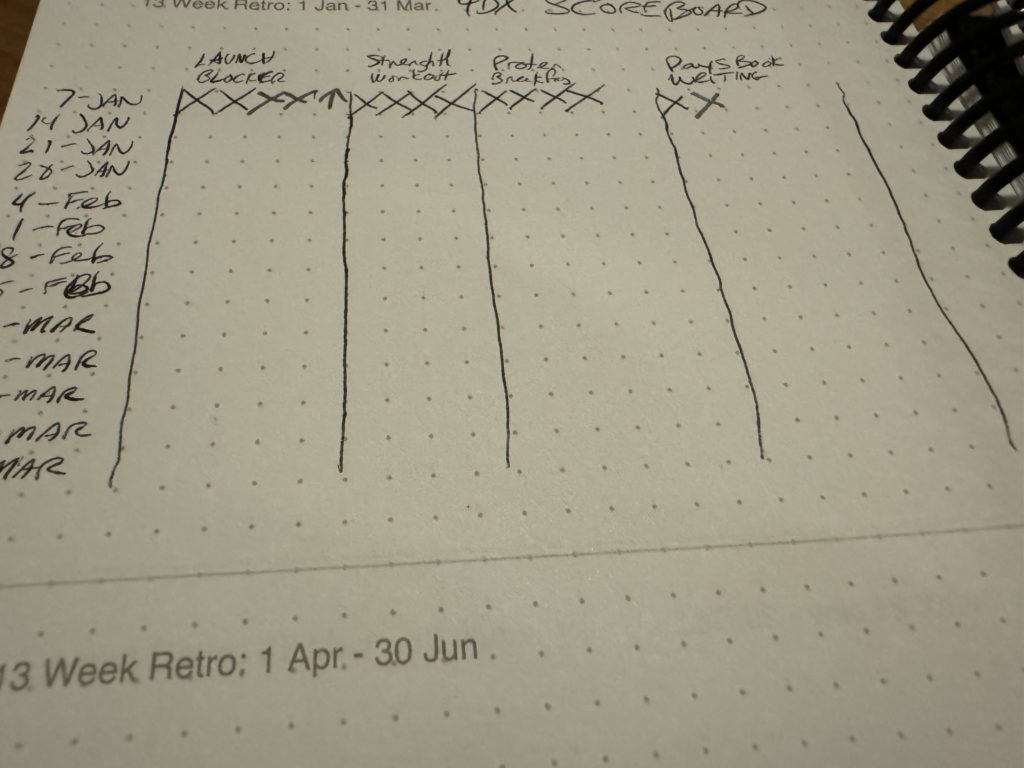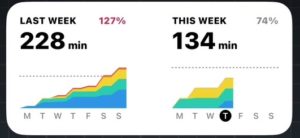I’m using techniques from The Four Disciplines of Execution (4DX) this year to help me reach my important goals. I documented my setup process in these posts:
- 4DX: Applying the First Discipline
- 4DX: Applying the Second Discipline
- 4DX: Applying the Third Discipline
- 4DX: Applying the Fourth Discipline
The gist is that you (1) identify an important goal (2) design and act on lead measures — things you control that you can do at any time that will add up to that goal (3) create a compelling scoreboard and (4) have regular accountability.
I chose to have 3 goals in 3 separate areas of my life that have segregated time. The book stresses having only one goal, because they are imagining that you apply this to work—I do have only one work goal.
For my work and personal growth goals, I have done my lead measures at or more than the level I wanted and I am making progress. Things seem to be going fine there.
For my fitness goal, I am doing what I set out to do, but I am not seeing progress, so it’s time to rethink if my lead measures are right. In my case, I think they are generally good things to do, so I will keep doing them, but they are obviously not enough.
In 4DX, we are supposed to periodically make sure our lead measures are taking us where we want to go. So, I want to share my thinking. The point is not my specific fitness goals or process—if you disagree with my fitness approach, that’s fine—the point is that I am trying to incorporate new knowledge and try something else.
Here’s my thinking:
My fitness goal is to reduce body fat with the lead measures of strength training and higher protein breakfasts. The result so far is that I am getting stronger (can do more pullups, lift more), but my body fat % hasn’t changed at all. My weight also hasn’t changed, but I am ok with that. I have been using a body fat scale since 2019, so I looked at my history, and I see that my lowest body fat % was when I was doing the most running. This is frustrating.
I chose to lower the amount of running I do because I am trying to avoid knee problems. I don’t have any now, and I want to keep it that way. During my lowest body fat periods, I was training for half and full marathons, which I am not planning to ever do again.
So, it appears that for me, I might need more cardio. From my research, I know that this may inhibit muscle growth, but that effect is because of calorie deficit. So, I will add more cardio (but low stress activities like swimming, rowing, and the elliptical) and I need to find a good healthy source of extra calories. I hate to rely on protein shakes, but that will be part of it. I have also seen some research that would indicate that I should substitute whole starches for tofu and tempeh because of their high fat content.
So, my breakfast will have fewer tofu scrambles with tempeh bacon and I’ll have to come up with a bean/quinoa breakfast. I also make an egg substitute from mung beans that has better macros than Just Egg, which I’ve been having a lot of. I will also cut bread as much as I can—mostly this is a problem because I use plant burgers as an easy lunch—I’ll just have to have it with no bun.
So, my new lead measures are to keep the strength workouts, add three 30+ minute low-stress cardio workouts, and keep the breakfast, but lean more on beans/quinoa/mung beans and less on tofu and tempeh, and skip the bread as much as I can. I will need more calories, but I will find them in whole starches.
In any case, don’t let my fitness choices distract you. The point is to periodically look at your desired lag measures for your goal and make sure your lead measures are moving towards it. It’s not something you can see every day, but I think four weeks is enough.

